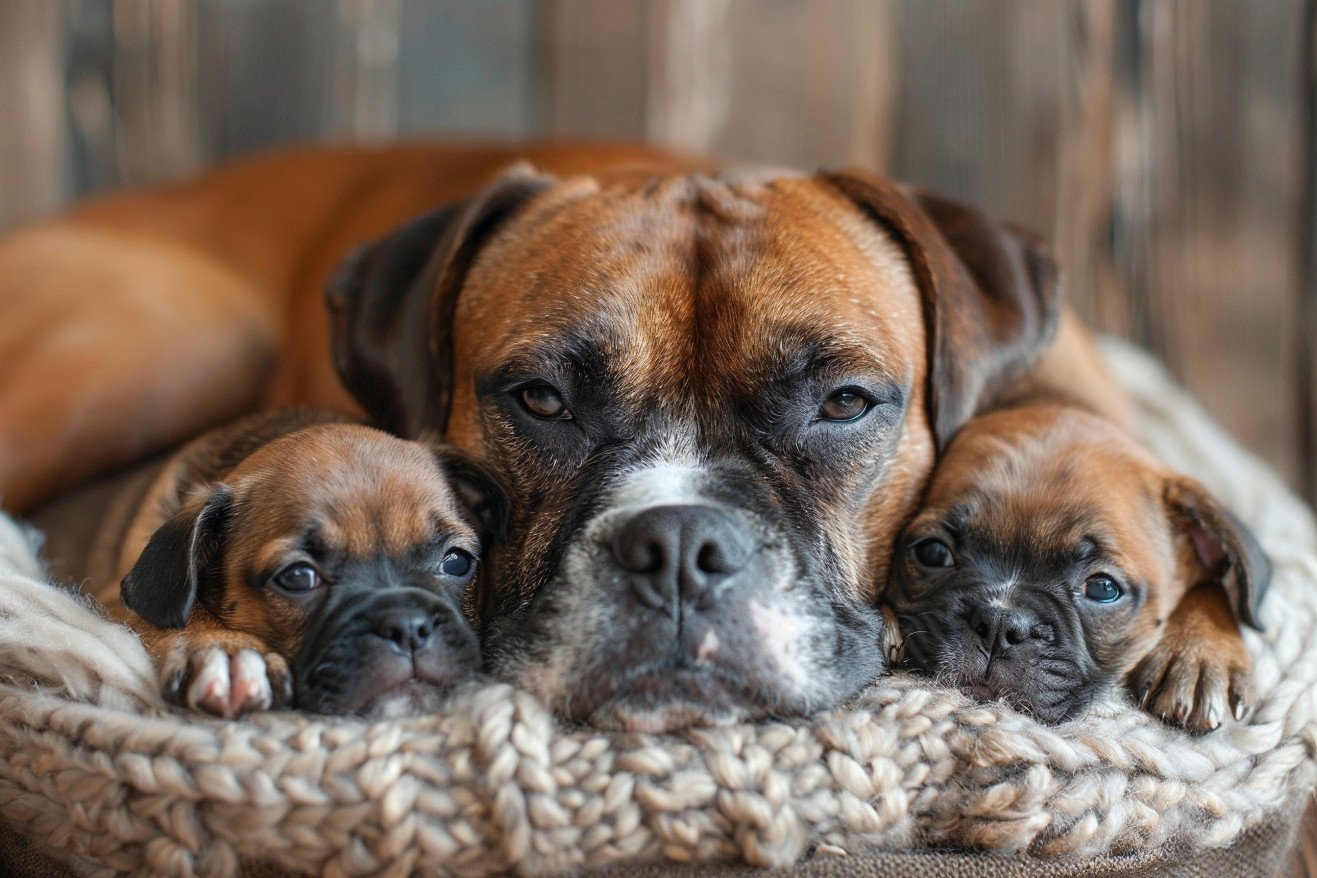Can Dogs Have Twins? The Science of Double Dog Births
7 May 2024 • Updated 6 May 2024

If you're a dog owner, you're probably familiar with the concept of a litter of puppies, but have you ever stopped to wonder if dogs can actually have twins, the way humans do? The answer is yes, dogs can have twins—and that includes both identical and fraternal twins. While it's rare, twin pregnancies in dogs are a natural occurrence, and certain breeds, such as Labradors and Boxers, are more likely to have litters that include twins.
In this article, we'll take a deep dive into the scientific research from the fields of veterinary medicine and animal genetics to learn more about this unusual biological event. We'll look at the evidence from biological studies and real-world examples of dog twins to better understand the likelihood, potential complications, and impact on the mother and her puppies. In the process, we hope to give you a better understanding of the fascinating ways in which our canine friends reproduce.
Can dogs have twins?
Litter Size and the Occurrence of Twins
The average litter size for dogs is 5.4 puppies, although litter sizes can range from 1 to 12 puppies, according to Dogster. Larger dogs tend to have larger litters, with many averaging 7 puppies or more. For instance, giant dog breeds like the Great Dane can have litters of 8 to 10 puppies or more, based on information from the Oakland Veterinary Referral Services. Conversely, toy and miniature breeds have smaller litters, with many having litters of 3 to 4 puppies, with the Teacup Chihuahua having the smallest average litter size of 1 to 3 puppies, according to Dogster.
Although litters with multiple puppies are common, the occurrence of true twin puppies, which develop from the same fertilized egg, is rare. Just because a dog has a large litter doesn't mean that the puppies are twins. A dog's breed, age, health, genetics, and even the method of breeding can all affect the average size of a dog's litter and the likelihood of having twins, according to Basepaws. This helps explain why some dogs may be more likely than others to experience the rare phenomenon of a twin pregnancy.
What Determines Litter Size and the Likelihood of Twin Pregnancies?
Perhaps the most important determinant of litter size is the size of the breed. Larger breeds tend to have more puppies per litter. For example, according to PetHelpful, Labrador Retrievers have litters of 5-10 puppies with an average of 7 puppies. Meanwhile, smaller breeds like Yorkshire Terriers and Chihuahuas have litters of 2-5 puppies with an average of 3.3 puppies.
The age of the mother also has an impact on litter size. In large breeds, the number of puppies born decreases in females over 5 years old compared to younger females, according to PetHelpful. This may be due to a decrease in the number of follicles or abnormalities in the uterine lining.
In addition to breed and age, a dog's health, nutrition, and stress levels can also impact litter size. According to Dr. Emmanuel Fontaine, poor health, deficiencies, and high stress may reduce the number of puppies. Genetics and inbreeding levels also have an effect, with a 1% increase in dam inbreeding leading to a 0.1 puppy decrease in litter size according to PubMed.
It's also worth noting that the method of breeding can impact litter size. Some Thoughts About Dogs reports that artificial insemination, especially with frozen semen, results in slightly smaller litters than natural mating. These factors help to shed light on the likelihood of twin pregnancies in dogs.
Identifying and Confirming Twin Puppies
Prenatal ultrasound scans can be used to identify twin fetuses in the womb, but it is difficult according to a retrospective study published in the journal Animals. The study also found that shared placentas and amniotic sacs are the most reliable ways to confirm twin puppies during pregnancy or birth.
After birth, identical twins will look almost exactly alike, while fraternal twins will look different. As noted on Wag!, this is because identical twins have the same DNA, even if they don't look exactly alike. Genetic testing, including DNA analysis, is necessary to confirm that puppies are identical twins, as was the case with the first documented instance of monozygotic twin puppies, which were discovered by veterinarian Kurt de Cramer in South Africa, and reported by ScienceAlert.
Because the rarity of this occurrence means many cases may be missed, it is important to closely monitor during pregnancy, birth, and after delivery to identify potential twin cases. This includes understanding the signs and confirming twin puppies. This is the first step in ensuring that the mother and her unique offspring receive the care and attention they need.
Dangers and Complications of Large Litters and Twin Births
There are several dangers associated with very large litters, including those that include twins. One of the most serious is the potential for complications during pregnancy and birth. According to Whelping a Large Litter, the mother dog's uterus can become so stretched and thin that the puppies are born through the uterine wall instead of the birth canal, which resulted in the death of both the dam and all 10 puppies in one case. The mother may also have difficulty producing enough milk and nutrients to feed an exceptionally large litter.
A study published in Identifying risk factors for canine dystocia and stillbirths found that large litters (over 9 puppies) had an intermediate dystocia (difficult birth) rate of 26.9%, and pups from these litters were 1.45 times more likely to be stillborn compared to smaller litters. Additionally, the last puppy born in any litter was significantly more likely to be stillborn.
Proper care, monitoring, and supplementation are important to ensure the health of the mother and her puppies in large litters. This includes daily weighing of the puppies, keeping them warm and clean, and weaning them onto solid food at around 4 weeks of age to help support the mother's milk supply, as described in 3 Ways to Care for a Large Litter of Puppies.
How to Care for Mother Dogs and Puppies in Large Litters
Caring for a mother dog and her puppies in a large litter, including a litter with twins, requires careful attention and care for both the mother and her babies. As noted by Companion Animals, the mother’s diet should be adjusted to meet her increased energy needs during lactation when she is feeding a large litter. This is especially important if she is feeding a litter of 12 puppies.
It’s also important to monitor the puppies’ weights and provide supplemental feeding for any puppies that aren’t gaining weight as they should.
In addition to this, it’s important to keep the puppies in a warm, clean, and quiet environment to reduce stress and the risk of illness. As noted on the Dogz Online Forums, weaning the puppies onto solid food at around 4 weeks of age can also help the mother out as her resources are stretched thin. Finally, it’s important to consult with a veterinarian to make sure the puppies are on the right schedule for vaccinations, deworming, and other care.
Overall, responsible breeding and good care are important for the mother and her puppies, especially when the mother has a large litter or is pregnant with twins.
Conclusion: The Fascinating World of Dog Reproduction
Even though they are rare, twin dog pregnancies are a great example of the amazing reproductive abilities of dogs. Knowing the average litter sizes, the factors that can impact litter size, and why twins are so rare can help people better understand dog breeding and genetics.
It's also important to make sure that mother dogs and their litters are properly cared for and monitored, especially when a mother dog has a large litter. More work is necessary to fully understand how common twin dog pregnancies are, what causes them, and what their impact is. However, responsible breeding and working with a veterinarian can help ensure that everyone stays healthy.


